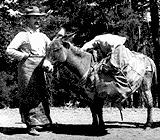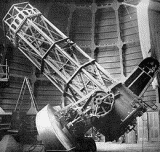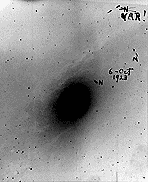
 - Discordant Evidence
- Discordant Evidence

 - Discordant Evidence
- Discordant Evidence
 'Picture yourself during the early 1920's inside the dome of the
60-inch telescope
on
Mount Wilson.
One of the men who had driven the mules that
carried the pieces of that same 60-inch telescope up the
old Mount Wilson trail
was
Milton Humason.
Humason stayed on at the observatory to become
janitor and then night assistant on the telescope. (Eventually he became
secretary of the Observatory and a delightful and famous astronomer.)
Humason was by then an observing assistant, and we can picture him talking
to the well known
Carnegie Institution
astronomer,
Harlow Shapley,
in that dome.
'Picture yourself during the early 1920's inside the dome of the
60-inch telescope
on
Mount Wilson.
One of the men who had driven the mules that
carried the pieces of that same 60-inch telescope up the
old Mount Wilson trail
was
Milton Humason.
Humason stayed on at the observatory to become
janitor and then night assistant on the telescope. (Eventually he became
secretary of the Observatory and a delightful and famous astronomer.)
Humason was by then an observing assistant, and we can picture him talking
to the well known
Carnegie Institution
astronomer,
Harlow Shapley,
in that dome.
 Humason is showing Shapley
stars
he had found in the
Andromeda Nebula
that appeared and disappeared on photographs of that object. The famous
astronomer very patiently explains that these objects could not be stars
because the
Nebula
was a nearby gaseous cloud within our own Milky Way
system. Shapley takes his handkerchief from his pocket and wipes the
identifying marks off the back of the photographic plate.'
Humason is showing Shapley
stars
he had found in the
Andromeda Nebula
that appeared and disappeared on photographs of that object. The famous
astronomer very patiently explains that these objects could not be stars
because the
Nebula
was a nearby gaseous cloud within our own Milky Way
system. Shapley takes his handkerchief from his pocket and wipes the
identifying marks off the back of the photographic plate.'
Of course, Hubble came along in 1924 and showed that it was just these
Cepheid
variable stars in the Andromeda Nebula which proved that it was a separate
galaxy system.
 Of course, if one ignores contradictory observations, one can claim to
have an 'elegant' or 'robust' theory. But it isn't science.
Of course, if one ignores contradictory observations, one can claim to
have an 'elegant' or 'robust' theory. But it isn't science.